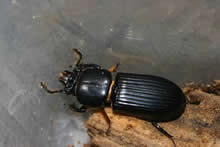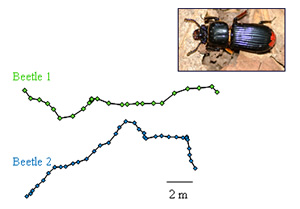Ecology and Management of Dead-Wood Arthropods
Coarse woody debris (CWD) provides important ecological services and supports high levels of forest biodiversity. Some estimates suggest that 1/3 of all forest species reside in dead wood. However, forest management practices (particularly prescribed burns) and modified disturbance regimes have resulted in the loss, fragmentation, and degradation of CWD. Thus, we need to identify how attributes of CWD influence saproxylic community (those organisms associated with decaying wood) richness and species abundances, and develop strategies to incorporate important CWD attributes into forest management practices. My former graduate student, Heather Jackson conducted her dissertation research on this system, focusing on the importance of habitat fragmentation and habitat boundaries on saproxylic species movement.
In particular, Heather conducted experiments with Odontotaenius disjunctus (Coleoptera: Passalidae), a species potentially very sensitive to CWD modifications, and a possible indicator of forest health and saproxylic species diversity. As with many CWD inhabitants, O. disjunctus is primarily flightless, and therefore probably greatly affected by management practices, such as prescribed fires, that decrease the abundance and increase the spacing of CWD.


In one set of experiments, Heather and several others from my lab quantified O. disjunctus dispersal behavior within forest stands and at the boundary between forest and non-forest habitat. These beetles are large (on the order of 4 cm) and easy to monitor their dispersal by simply following them in the forest and at forest boundaries and marking their positions at 1-minute intervals (see Jackson et al. 2009). Heather's research revealed that movement was 1.6 and 2.7 times faster and 1.1 and 1.5 times more linear in suitable habitat (forest) than in unsuitable matrix (lawn and pasture, respectively). Net displacement in the forest exceeded predictions of a correlated random walk, but net displacement in matrix habitats was less than expected. When confronted with a high-contrast boundary,O. disjunctus was 14 times more likely to move toward the forest than the pasture.
In a more recent study (Jackson et al. 2012), Heather examined how environmental and intrinsic factors at multiple spatial scales influenced beetle incidence in logs. Forest cover best predicted incidence at 225 ha, but accounted for only 1.2% of variation in incidence. Incidence was most sensitive to environmental factors measured at the finest scale (i.e. territories). Incidence was positively associated with moderately decayed wood and increased surface area of logs (9.9% and 3.1% of variance, respectively). When environmental factors were accounted for, spatial autocorrelation in incidence was greatest within subplots and logs, consistent with the hypothesis that intrinsic autocorrelation is associated with O. disjunctus average dispersal distance (<5 m). This study indicates the influences of factors acting at multiple scales, but suggests that environmental conditions at the scale of territories may be most important for species incidence.
Heather's final project focused on the mechanisms underlying density–area relationships (correlations between population density and patch size) in O. disjunctus (Jackson et al. 2013). It is often assumed that higher density on large patches is evidence that large patches are high quality, but the same pattern could result from disproportionate movement from small to large patches. In separate experiments we quantified (1) immigration into and (2) finite growth rate within logs (=patches) that varied in size and density of conspecific beetles. A log was 11.7-fold and 10.5-fold more likely to contain a new immigrant if it was large or contained a conspecific pair of beetles, respectively. Neither log size nor conspecific density was associated with changes in finite growth rate that would lead to higher density. We conclude that movement behavior rather than habitat quality is responsible for the positive density–area relationship for O. disjunctus. An important implication of our results is that population density is an imperfect indicator of habitat quality.
One of our long-range goals is to use this research to help guide development of CWD management strategies, and set the stage for future studies that include experimental manipulations of CWD, large-scale evaluation of management practices on saproxylic communities and CWD, and mathematical models that simulate impacts of alternative CWD management practices.








